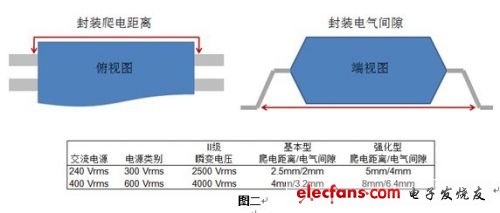This article will discuss how to build reinforced insulation in optocouplers and digital isolators according to the structural and test requirements of IEC60950, related IEC60747-5-5 and VDE-0884-10, as well as other recognized IEC standards for both isolators. The difference.
Safety isolation
Modern systems require isolation for a number of reasons, such as communicating with high-end devices in battery charging systems or motor drives, interrupting ground loops in communication systems, or protecting users from dangerous lines or secondary voltages. The level of isolation depends on the level of safety required for the specific application. Functional isolation does not provide protection for the user, providing only the insulation required for the device to function properly. The basic or single insulated level of electric shock protection is sufficient to protect the operator when there is no insulation fault. However, in order to protect personnel from dangerous voltage damage, the regulation requires that a separate insulation system be provided for the protection against electric shock, and a supplementary layer is required to ensure that when the fault bridges an insulation system, another redundant system can still operate. The safety of the staff. This design is called double insulation. The primary requirement for insulation is safety rather than electrical function, so the failure criterion during evaluation is whether the barrier is intact after certification, and it is better if the device still meets the original specifications.
Modern systems increasingly need to pass information through the isolation barrier. For example, in power control and feedback applications, data must flow from the SELV (Safety Extra Low Voltage) side of the AC/DC converter to the line side of the power supply. The operator can access the SELV end of the power supply, so there must be two separate isolation systems in the data path to protect the operator from electric shock. Passive devices such as resistors or capacitors can be operated in series without significant degradation, but placing two data isolators in the path is not feasible for several reasons. First, analog data will lose fidelity, and digital data will have long propagation delays and additional jitter. Second, an intermediate power supply is required to operate the coupler interface between the two insulation layers. Since data isolation devices are unrealistically doubled, it is necessary to connect individual devices directly across the double insulation boundary without sacrificing safety. Such devices (Figure 1) are classified as reinforced insulation devices.

Device level requirements
Device reinforced insulation is evaluated in two ways, one is the external dimensions of the device, such as creepage distance, gap and leakage index, and the other is internal electrical performance. Internal and external requirements are handled in much different ways.
The external dimensions must be equal to the total distance provided by the base layer and the supplemental layer of the double insulation system. In general, all creepage distances and clearances of the reinforced device are twice that of the basic/complementary rated device. Figure 2 illustrates two common operating conditions and the required creepage distance and clearance. This method is used because the external environment and surface characteristics can determine the external spacing requirements, including the expected amount of contaminants, air pressure, and the tendency of the outer surface of the device to be eroded by surface discharges. This is called leakage tracking.

The method of evaluating the internal characteristics of the device indicates that the insulation quality is more important than having the required insulation thickness. Manufacturers can therefore demonstrate that the device has the required electrical characteristics to withstand long and short term voltage stresses.
The requirements of the IEC60950 standard apply to office and telecommunications equipment and to medical devices to a large extent. External dimensions and materials can be easily verified with a micrometer and the leakage index is verified by bulk material testing. For internal requirements, there are three ways to authenticate a device.
Evaluation can be made assuming the device contains only solid insulation. This is the easiest method and requires that all internal distances within the insulation or along the bonded joint be greater than 0.4 mm. No further testing is required. However, high performance data couplers that meet these requirements are difficult to manufacture. It is widely believed that the minimum insulation thickness of 0.4 mm is suitable for all reinforced isolation devices; this is not the case and many engineers are confusing.
If the device is an optocoupler, the IEC 60747-5-5 standard should be used. This is a rigorous standard designed to certify optocoupler reinforced insulation, including a series of type and life tests, and an isolation withstand verification test after each test.
The device can be considered a semiconductor device. Such devices have a set of type tests similar to the requirements of IEC 60747-5-5. This method is used by digital isolators because the standard test requirements for optocouplers are tailored to the optocoupler structure.
18650 battery is cylindrical rechargeable Lithium Ion Battery. for 18650 single cell, its size is high 65mm and diameter 18mm.18650 also has many advantages,such as high energy density, excellent charge retention, long cycle life, low self-discharge rate, low resistance, no memory effect and non-pollution. our company has been committed to manufacture 18650 battery pack for many years. Hope to provide best green power solution for you!
Cylindrical Lithium Ion Battery-18650
Cylindrical Lithium Ion Battery-18650,18650 Lithium Ion Battery,18650 Li Ion Battery,Lithium Battery
Shenzhen Powercom Electronics Co., Ltd. , https://www.expowercome.com